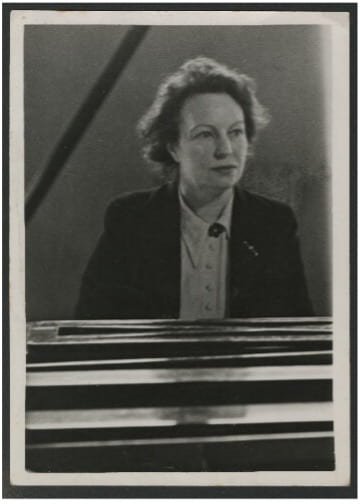Louise Hanson-Dyer and Editions de l’Oiseau-Lyre International Research Network
Recording Artists: Isabelle Nef

Louise Hanson-Dyer helped to establish, strengthen, and promote the careers of many recording musicians. From the 1930s, she carefully considered the artists who appeared on the Éditions de l’Oiseau-Lyre’s recordings, once writing that she only engaged professional musicians of the highest standing, “regardless of cost,” and that she had once waited two years to get “the right singer, the right artist with the right voice, and the right artistry.[1] She hired musicians at the beginning of their careers as well as established artists and was attentive to their needs, often going the extra step to ensure that they were met with the best possible conditions. During the recording process of Venus and Adonis in 1950, for example, she made sure that Margaret Ritchie, as per the soprano’s request, would have an extra day of rest in between her travel from London to Paris, her own room to rest in between rehearsals, and that she would be provided with her preferred diet of the “simplest kind”: soup, omelette and fruit.[2] After she had finished working with musicians, Hanson-Dyer often maintained a friendly relationship with them, continuing to recommend them for opportunities throughout her networks and supporting their careers. In 1960, for example, she funded Margaret Ritchie’s summer school for singers in Oxford, which, thanks to its initial success, continued to run annually until 1963. In return, Ritchie included a large quantity of the Éditions de l’Oiseau-Lyre’s publications and recordings in the course, exemplifying the kind of mutually-beneficial relationship that Hanson-Dyer spontaneously fostered.[3] As a testament to their gratitude towards Hanson-Dyer, many musicians sent her signed photographs, thank you letters, and sometimes recommendations for other singers or compositions to record.
Isabelle Nef

Nef (née Lander) was a Swiss musician who taught harpsichord and music history at the Geneva Conservatoire for the entirety of her life, whilst also travelling internationally to record, perform, and teach. As a child, she learnt piano with Marie Pathès in Geneva and later transferred to Isidor Phillip at the Schola Cantorum in Paris, where she also studied composition with Vincent d’Indy. In the early 1920s, Nef began taking harpsichord lessons with Wanda Landowska, who remained her teacher and friend for the next twelve years—it is probably during one of Nef’s frequent visits to the French capital that she met Louise Hanson-Dyer. Nef began recording with Hanson-Dyer in 1939 and became the Éditions de l’Oiseau-Lyre’s most recorded woman instrumentalist. They recorded a significant number of early compositions together, notably J.S. Bach’s Well-Tempered Clavier in its entirety (OL 29–33), as well as two modern compositions by the Swiss composer Frank Martin in the 1950s (OL-LD 17 and OL-LD 94). As a student of Landowska, Nef was also an important figure in the revival of the modern harpsichord, and alongside Hanson-Dyer, contributed to the twentieth-century early music revival. Throughout her life, Nef recorded very little for labels other than the Éditions de l’Oiseau-Lyre and she stated that her recordings with Hanson-Dyer had “launched her career."[4] In a 1963 interview, she touchingly recalled how at times, they had “worked all night, without stopping, whilst drinking coffee to keep us going. In the end, it was so good! The more we made progress, the better I played![5]
Listen to Isabelle Nef play Gigue by Elizabeth Jacquet de la Guerre (OL 75B) on SoundCloud
By Thalia Laughlin
PhD candidate
University of Melbourne
August 30, 2021
[1] Letter from Louise Hanson-Dyer to Sybil Hewet, 20 March 1943, Louise Hanson-Dyer, Papers, 1926–1971, Box 1536, File 1, MS 10770, State Library of Victoria, Melbourne, Australia.
[2] Letter from Margaret Ritchie to Louise Hanson-Dyer, 22 October 1950, EOLA 2016.0034 Unit 6 (2016.0034.00156).
[3] Letter from Margaret Ritchie to Louise Hanson-Dyer, 12 June 1960, EOLA 2016.0034 Unit 5 (2016.0034.00124); “Summer School for Singers,” The Times, 8 April 1960, 20.
[4] “Ce sont les disques qui m’ont ‘lancée,’ les enregistrements organisés par M. Dyer, à l’enseigne de l’Oiseau lyre-Decca.” In Blanche Strubin, “Isabelle Nef ou la musique vécue,” Revue musicale de Suisse Romande, no. 9 (October 1958), 186.
[5] “Il nous est arrivé de travailler toute la nuit, sans arrêter, en buvant du café pour continuer! A la fin, c’était tellement bien! Plus on avançait et mieux je jouais!” In Blanche Strubin, “Isabelle Nef ou le don de communication,” Tribune de Genève, 12–13 October 1963, in Liner notes for Isabelle Nef: Clavecin—clavicorde—pianoforte (enregistrements inédits), VDE-GALLO, 1987, 331/3 rpm microgroove LP record.

Photographs of Isabelle Nef, sent to Louise Hanson-Dyer, are housed in the Editions de l’Oiseau-Lyre archive (EOLA 2016.0034.00137, Unit 6).